ADO Den Haag has been synonymous with the Eredivisie for much of the 21st century.
Their promotion from the second tier in 2003 was followed by a four-year stay in the top flight before their relegation in 2007, but they returned the very next year.
After a period of consolidation, they became mainstays in the Eredivisie, finishing as high as seventh in the 2017/18 season.
However, their 13-year stint at the top came to an end in 2021 as they dropped back to the Eerste Divisie.
ADO undertook an instant bid for promotion, finishing fourth in the standings to make the playoffs as they topped the league table in the first eight rounds.
They made it to the playoff finals, where an exciting tie with Excelsior ended 5-5 after two legs, with the latter then winning 8-7 on penalties to move to the top flight.
The defeat seemingly lingered on in Hague as the club endured a dismal 2022/23 campaign, finishing 12th in the Eerste Divisie after winning just 13 of their 38 matches and scoring only 51 goals while letting in 57.
Veteran manager Dick Advocaat, who took over the reins in November 2022, departed at the end of the season.
In came Darije Kalezić, who has since transformed ADO Den Haag’s fortunes. De Ooievaars currently sit third in the Dutch second division with 53 points from 28 matches, just four behind leaders Willem II and one behind second-placed Roda JC.
They have the second-best attack in the league with 58 goals (only behind 10th-placed Hamburg, who have 61), and their defence has also improved.
With 10 matches to go, including a massive fixture against Roda this weekend, ADO are in pole position to win promotion.
But how have they gotten here following the disappointments of last season? This tactical analysis report will dive into the changes Kalezić has brought about, along with some analysis of ADO’s tactics, performances and most-improved players.
Who Is Darije Kalezić?
Kalezić, whose playing career lasted 15 years, boasts plenty of managerial experience, particularly in the Netherlands, but his resume makes for curious reading.
The 51-year-old’s stint on the sidelines began with De Graafschap, the last club he played for before retiring in 2006.
He was named their U21 team’s assistant manager almost immediately after his retirement and took over the same role under Henk van Stee in the first team a year later.
When Van Stee was fired in early 2009, Kalezić took over the reins and secured promotion to the Eredivisie that season.
He held the position until the end of the 2010/11 season, guiding De Graafschap to a 14th-place finish in the top flight before they parted ways.
The Dutchman then had short-lived stints at Zulte Waregem and Stockport County before stepping back to become the U21 manager at PSV Eindhoven, a role he held from June 2013 to June 2015.
ADO Den Haag’s current competitor for promotion, Roda, then came calling, and Kalezić managed them for one season, guiding them to a 14th-place finish in the Eredivisie.
He then moved to Al-Taawoun in the Saudi Pro League in the summer of 2016 but left the club after just seven matches.
A move to A-League outfit Wellington Phoenix followed in June 2017, but this was short-lived as well as he departed the team in March 2018 after winning just four of his 21 matches in charge.
Kalezić joined Indonesian outfit PSM Makassar in February 2019, leading them to Indonesian Cup success that season.
However, Makassar’s form fell the following season as they won only 24 of their 53 matches, leading to Kalezić’s departure.
A one-year stint with MVV Maastricht followed before the former De Graafschap centre-back joined Utrecht’s U21 team in May 2021.
His two seasons with the team didn’t yield great results, as they finished 18th in the 2021/22 and 20th in the 2022/23 Eerste Divisie seasons.
However, ADO chose to trust Kalezić regardless.
So far, it has been the right move.
ADO Den Haag: Key Statistical Changes under Darije Kalezić
A quick overview of ADO Den Haag’s statistical profile under Advocaat last season and Kalezić indicates that the latter hasn’t changed too much and has merely fine-tuned his team’s approach across the field.
Starting from the backline, De Ooievaars have improved their defensive organisation, conceding fewer shots (but a higher percentage of shots on target) and, consequently, fewer goals.
They have also worked harder to recover the ball when they lose it.
However, the most significant change is arguably in their pressing patterns, as their passes per defensive action (PPDA) have experienced a major jump from last season.
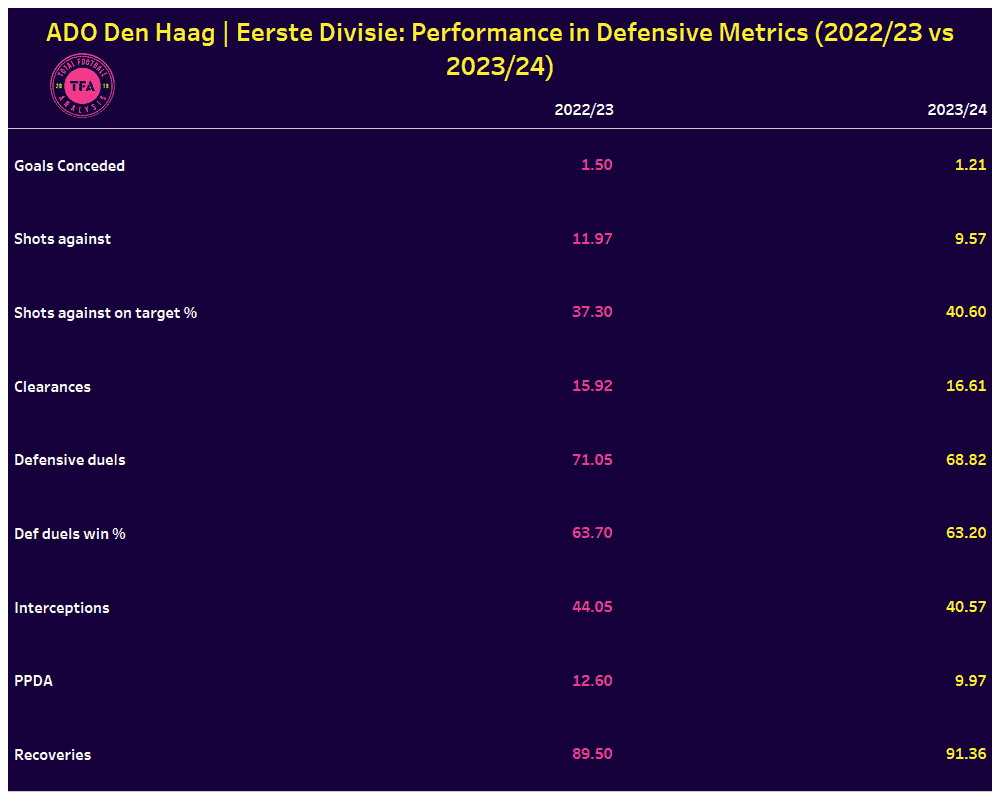
In midfield, Kalezić’s side is enjoying more possession, which has, in turn, led to increased passing volume and marginally improved passes per possession.
They have maintained a similar accuracy rate across the board, including in long passes, which is impressive given the increase in volume.
With respect to creativity, the team’s accuracy from crosses has dipped, but there have been improvements in volume and accuracy with regard to passes into the final third and progressive passing.
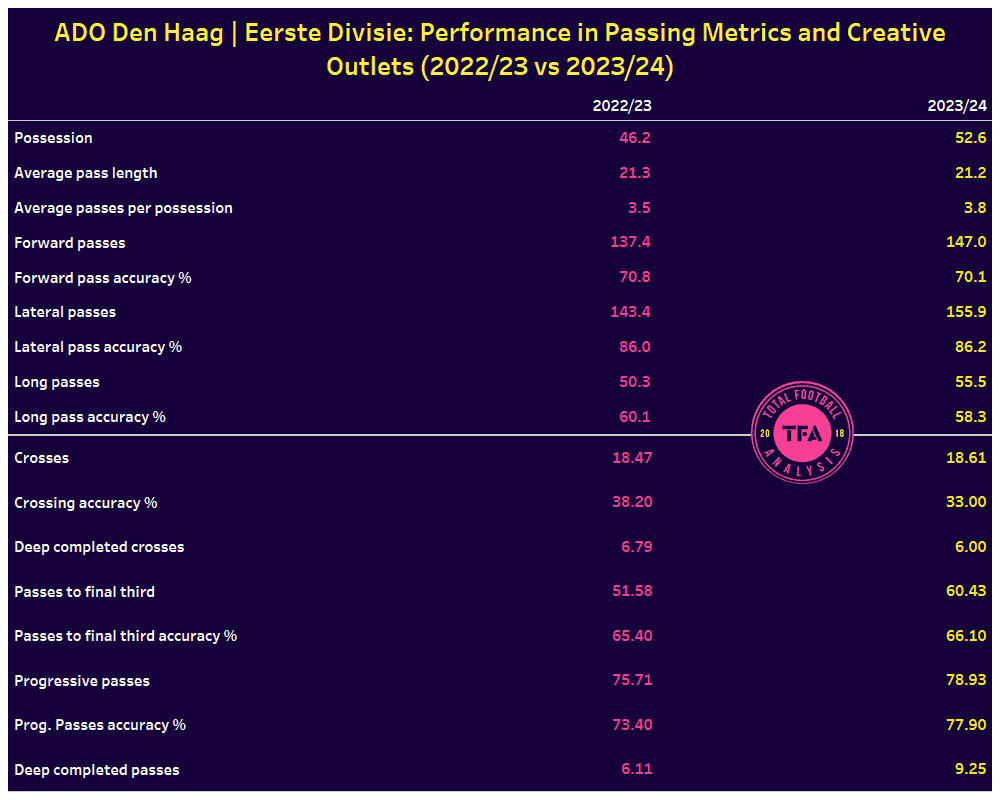
Lastly, in attack, Kalezić’s team are getting more shots on target despite shooting from outside the box on more occasions.
They are overperforming their expected goals figure, but it seems like a levelling of the scales after they underperformed last season.
More possession and final-third entries have also seen them win more corners, and more than a third of their corners end in shots.
ADO also pose a threat on counterattacks, but their proficiency from free-kicks remains quite low.
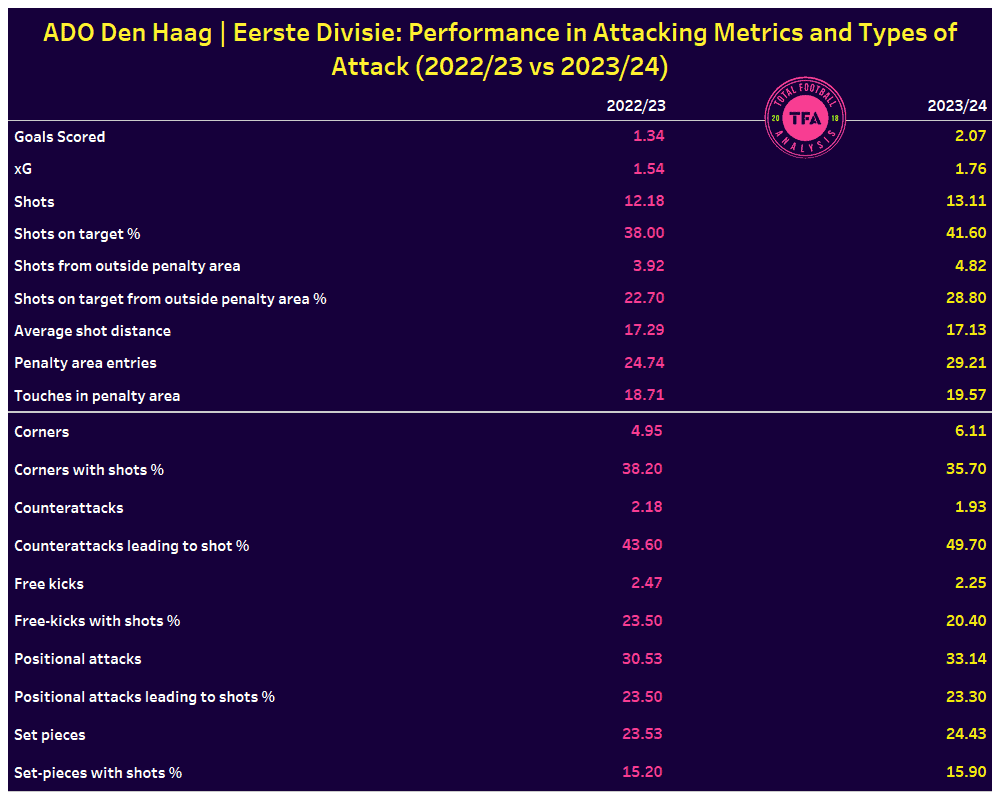
Darije Kalezić Formations and Personnel
This season, Kalezić has largely picked a 4-2-3-1 formation.
The goalkeeper position has been a bit of an issue, with the Dutchman using as many as three custodians in the first half of the season.
However, January arrival Nick Marsman seems to be the first choice now, having started each of the club’s last seven Eerste Divisie matches.
Matteo Waem and Bart van Hintum have accumulated the most minutes at centre-back, with Tyrese Asante and Timothy Derijk also receiving minutes.
Van Hintum has also played at left-back when needed, alternating with Amir Absalem, while Henri Koudossou has been the regular right-back.
Skipper Kursad Surmeli has been the preferred starter on the right side of holding midfield and has had Dhoraso Klas and Lasse Vigen for company.
Ahead of them, Jort van der Sande, a centre-forward by trade, has played as the 10, often flanked by left-winger Joel Ideho and right-winger Daryl van Mieghem.
Jerry van Wolfgang has also played on the left in recent times.
Upfront, 33-year-old Henk Veerman has been the preferred option, having started all 28 of their Eerste Divisie matches so far.
Overall, this is largely an XI compiled of veterans, which has undoubtedly helped Kalezić.
Marsman, Van Hintum, Derijk, Van Mieghem and Van Wolfgang are all over 30 years of age, while Vigen is 29 and Surmeli and Van der Sande are both 28.
However, there is also a young core in the form of Waem (23), Asante (21), Koudossou (24) and Klas (23) that could be key to the club’s future.
Darije Kalezić Build-up Play and Chance Creation
ADO’s build-up patterns under Kalezić have followed the popular trend adopted by most managers who play four defenders at the back.
The centre-backs often bring the ball up the pitch, with either one full-back in support and the other high out wide or both high out wide, with one of the holding midfielders dropping back for assistance.
The full-backs’ width allows the wingers to come inside and help achieve a numerical advantage in the final third and get multiple players into the box when they circulate it out wide.
The centre-forward largely operates between the two opposing central defenders, though he has also shown the ability to link up play.
Quite often, the attacking midfielder makes late runs into the box to meet cutbacks, an aspect we will explore later on.
Consider the following sequence from ADO’s latest match against Ajax II.
Here, the centre-back plays a line-breaking pass to the striker, who flicks it onto the right-back.
The latter now has options all over, starting with an underlapping right-winger and extending to a player in the box, a runner making his way in, and the opposing winger at the far post.
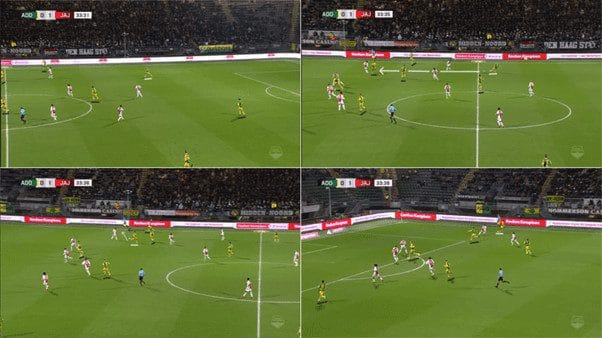
They are also adept at escaping a higher press than what we see from Ajax II above, as displayed in the case below from their match against MVV.
Here, the holding midfielder drops deep to receive the ball, with both full-backs operating out wide.
He finds the left-back, who chooses to go back to the central defender.
However, with these three passes, ADO have pulled MVV to the left, giving the right-back acres of space.
The right centre-back floats a ball over to the right-back, who then cuts it back to his teammate arriving late.
The latter tries a flick to the far post, but it doesn’t come off, and the opposition clears their lines—but only briefly.
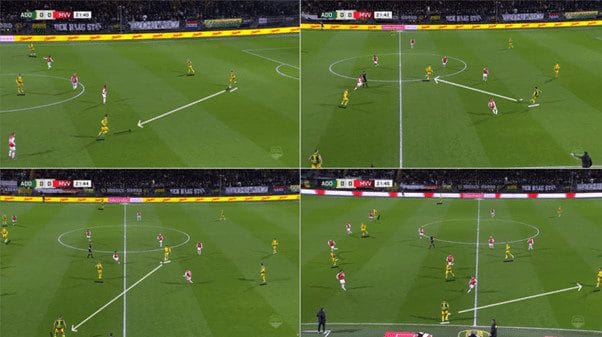
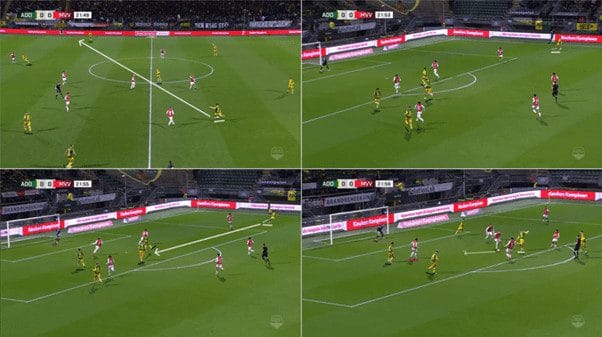
ADO regains the ball in midfield and passes it back to the centre-back, who once again lofts it over the top to the right-back as MVV struggles to recover lost ground.
This time around, the right-back fizzes a ball into the box, and it’s met near the penalty spot by the centre-forward, whose shot cannons back off the bar.
Notice that ADO once again has four men in the box and finds a way to get a shot away despite the presence of five defenders.
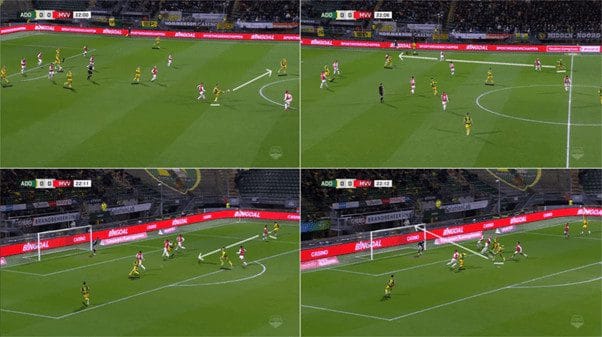
These two sequences are also backed up by ADO’s shot assists map, which shows a bulk of chances coming from balls played into the box from out wide, with fewer centralised assists.
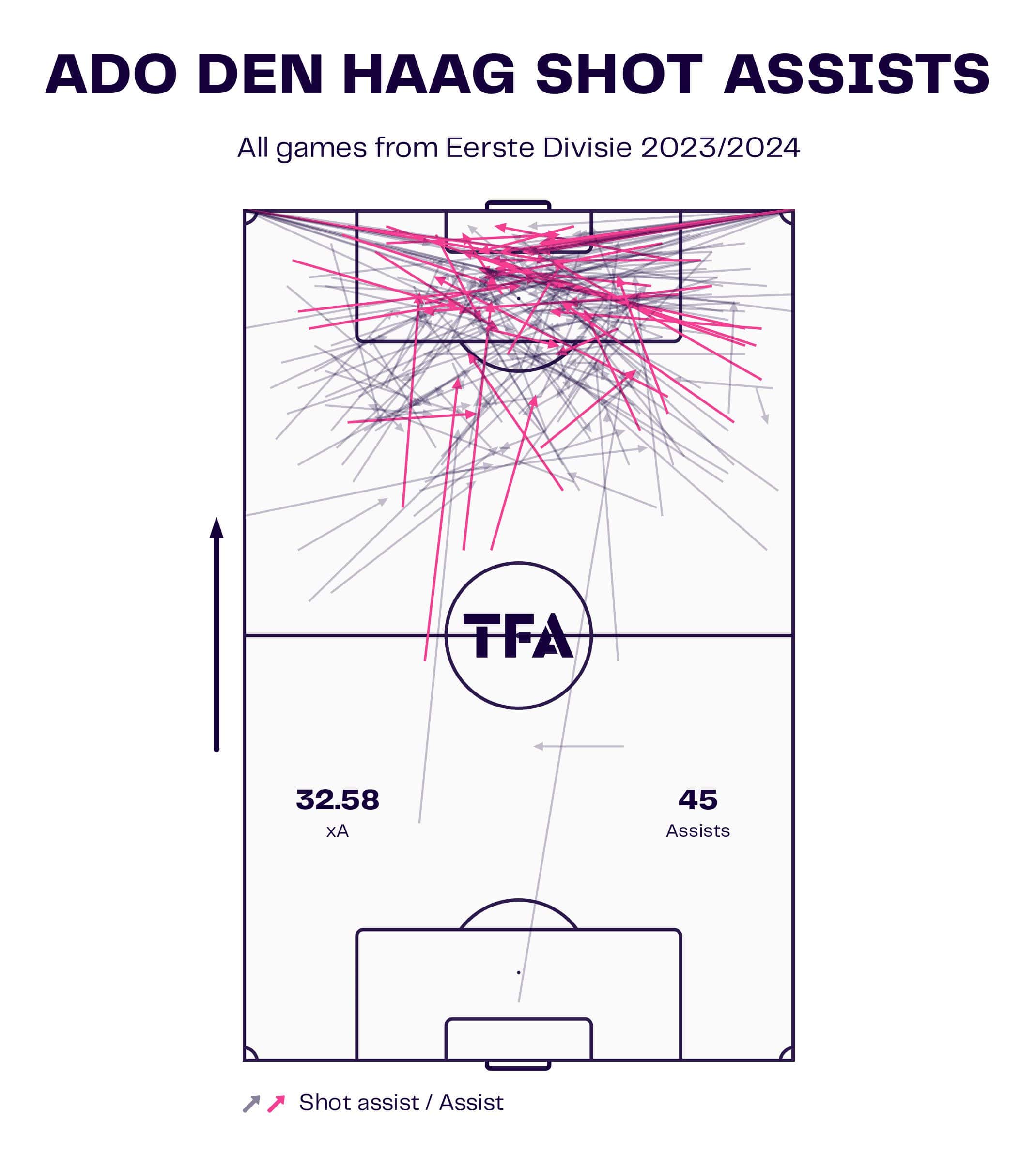
Goals: The 3 Vs lead the charge
ADO Den Haag’s primary sources of goals in the Eerste Divisie this term have been striker Veerman, attacking midfielder Van der Sande, and right-winger Van Mieghem.
Veerman is second in the entire division.
Van der Sande has been an excellent creator, with seven assists to go with his 10 goals.
Lastly, Van Mieghem leads the league’s assists chart with 14 while also chipping in with seven goals.
Veerman, at 33, is as experienced a striker as you can get in this league and has displayed that time and again.
Consider the following sequence from ADO’s match against Emmen: some neat link-up play on the left allows Van Mieghem to get into the box.
He miscontrols the ball but somehow chips it over a couple of defenders towards Veerman.
The striker backs into his defender to let the ball run across both of them.
This then sets him up for a volley, which he smacks in between the defender and goalkeeper first-time to score.
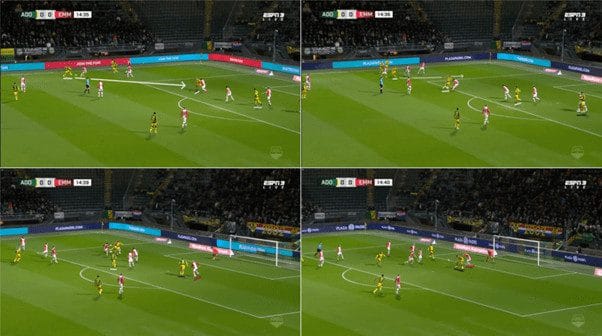
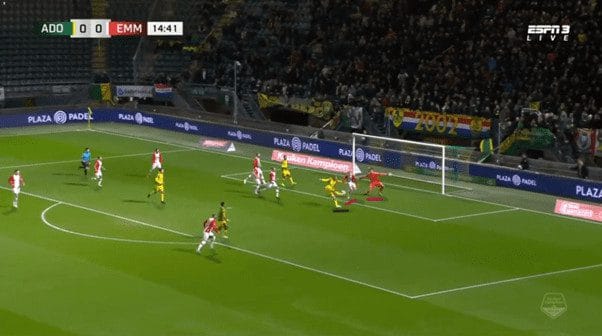
There’s a lot more to Veerman’s game, as he has scored with both feet and his head so far.
More importantly, he also has the deft touch strikers occasionally need to make converting half-chances look simple, as in the case below from ADO’s match against NAC Breda.
The goal is also an excellent example of Van Wieghman’s movement in the final third.
In this move, the latter ideally times his run across from the right wing to a central area to collect a long ball from the defence before turning and laying it off for Veerman.
The veteran is faced with a sliding defender but comes up with an impudent dink over him and the goalkeeper to score with one of the best finishes of the season.
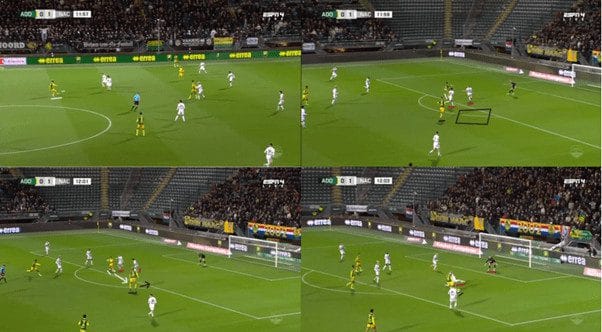
Meanwhile, as briefly touched upon earlier, Van der Sande has made it a habit to make late runs into the box to score his goals this season.
One example of the same comes in this strike against Venlo following a classic “ADO under Kalezić” move that sees the centre-back float the ball over to the right.
The delivery from the right is excellent and met by Van der Sande, who, as evident from the grid, initially runs into the box from behind the play to guide it home, unmarked from close range.
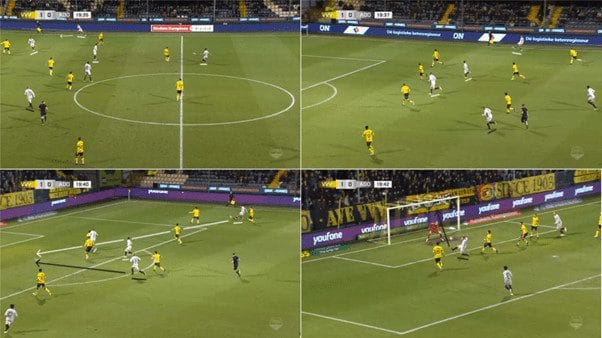
Additionally, in a team that creates most of its chances from out wide, Van der Sande offers the ability to make plays from central areas like this through-ball against Helmond Sport for Veerman, which takes out the entire opposing defence.
Veerman then shows immense composure to take it beyond the goalkeeper and slot it home.
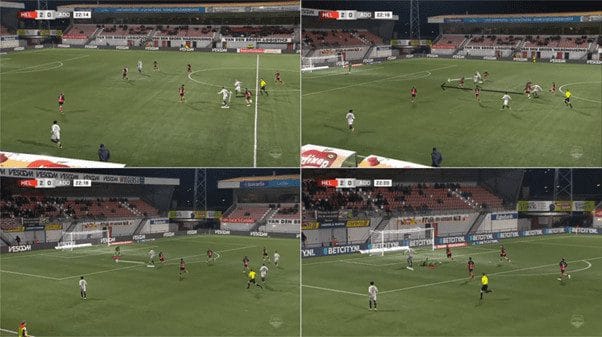
Apart from this trio, 23-year-old Malik Sellouki is one to watch.
He has scored five times in just 518 minutes of action (excluding stoppage time), while Ideho has also scored four goals.
Waem, Koudossou, Vigen, Alex Schalk, and Derijk have all scored two goals each.
Defensive Shape and Room for Improvement
Like many other teams across Europe, ADO looks to defend from the front with specific pressing triggers.
As the sequence below shows, they allow the initial passes between the opposition centre-backs, but as we see in the top-right tile, the first passage of pressing begins from a winger when the ball moves wide.
As it’s played across the box from there to the other side, the winger on the other flank also presses his man.
Just as the opposing centre-back plays the pass, two more ADO players press high, making it a 6v6 and baiting a difficult switch.
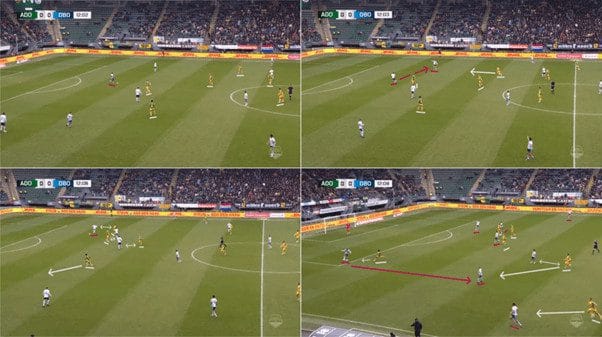
Evidently, this requires plenty of coordination, with even one missed run opening up space for opponents.
While ADO’s defensive record has improved under Kalezić, they are still conceding over one goal a game and at times, it has been because teams play through their press due to one or two players misreading their assignments.
Consider this goal they conceded against De Graafschaap, who easily found the open man while building out from the back due to one of the ADO players failing to mark his man.
They then tried to overcompensate for that, allowing the player to chip the ball over to the wide man.
He then laid it back for his teammate, whose scuffed effort ended right at the feet of an open man at the far post to finish the move off.
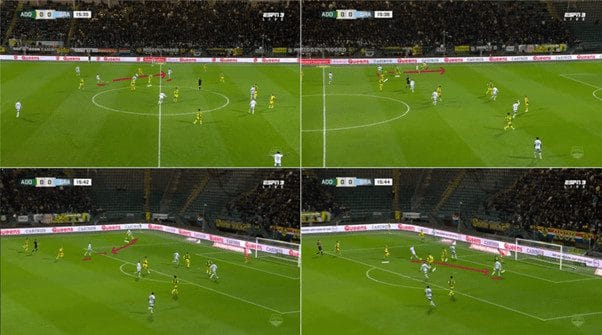
Another example of this can be seen in their match against MVV.
The press initially forces the opposing player wide in his own half, but on the same flank, we notice an MVV player easily run in front of an ADO defender to get behind him, with a lack of communication forcing the latter to press too high.
The ball over the top is perfect, and MVV has acres of space.
This move ended in a goal after the player on the right found his teammate at the far post with a ball across the box.
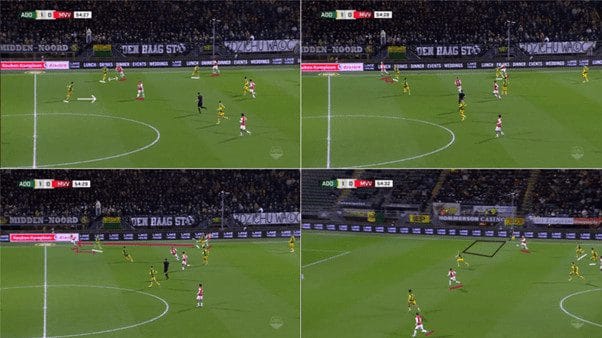
This, along with their defensive territory map below, show that ADO’s defensive organisation under Kalezić, while improved, can still be better.
The Dutch tactician has them making more defensive actions further up the pitch than last season with better pressing, but at times, their midfield can be bypassed a little too easily, and given that the first line of defence largely works on triggers, this might leave their backline far too exposed.
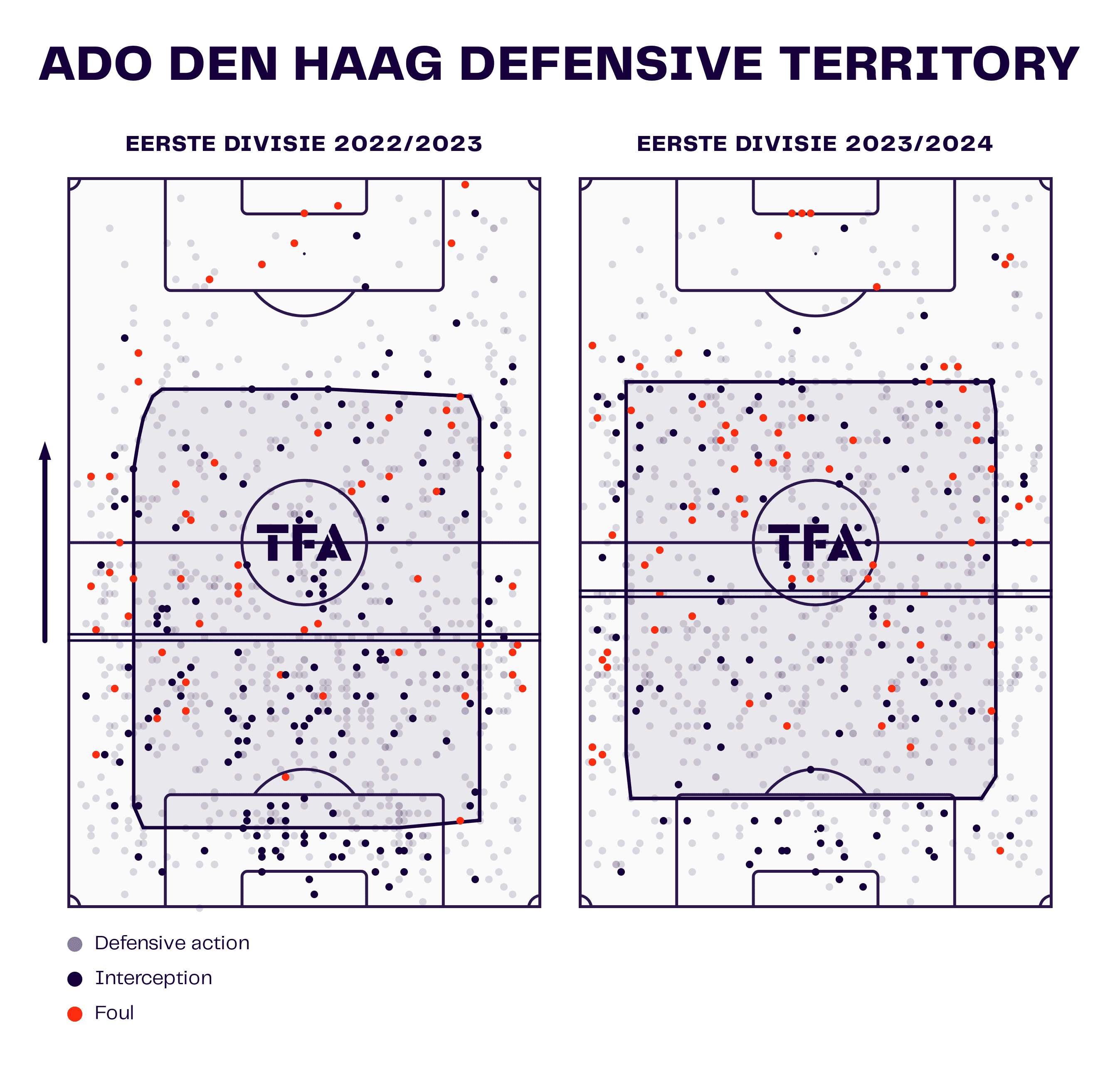
Another point worth noting about ADO’s defending in the league this season is the team’s tendency to concede early goals.
Out of the 34 goals they have conceded, more than 1/3rd (12) have come in the first 15 minutes of either half, while more than half (18) have been scored by opponents in the first 20 minutes of either half.
When this is broken down further, eight of their goals conceded (23.5%) have come within the opening 15 minutes of the match itself.
This is certainly an aspect Kalezić and his players will need to work if the team is to get better, particularly if they do manage to get promoted to the Eredivisie.
Conclusion
ADO Den Haag have put together an excellent and rather unexpected season so far and are in a good place with respect to gaining promotion.
They have been managed extremely well by Kalezić, while their experienced frontline has delivered goals and assists aplenty.
The defence, which is arguably the youngest part of their team, has shown glimpses of quality but can undoubtedly improve and will need to do so for them to keep their promotion charge going.
Overall, though, ADO are trending in the right direction.
Kalezić deserves plenty of credit for resurrecting a team that looked pedestrian at best last season to a title challenge this time around.





Comments